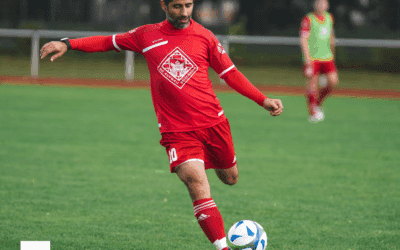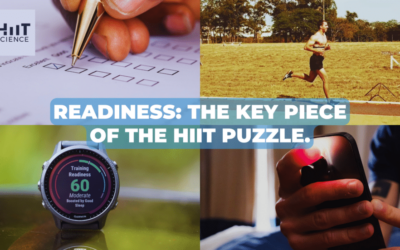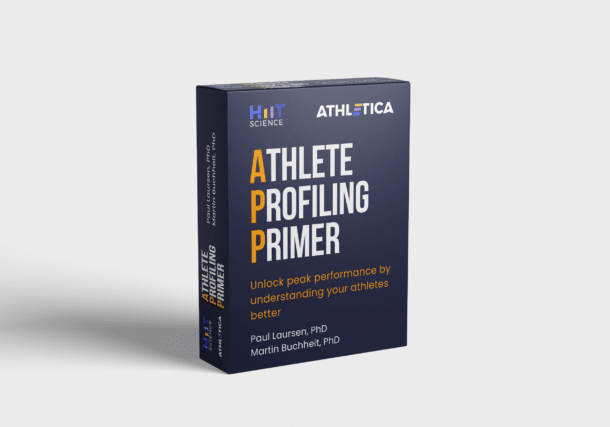What is priming?
You’ve probably heard of priming before. The term ‘priming’ means “preparation for action” and can be used in numerous contexts. Scientifically speaking, priming relates to the phenomenon whereby exposure to one stimulus influences the response to a subsequent stimulus. In sport, we often use the term to refer to a bout of exercise prescribed before a competition (1 to 48 h), with the goal of positively influencing the athlete’s performance (1). Although these definitions (and time periods) may assist us in the research setting, it can sometimes be difficult to relate to in practice as it doesn’t consider all of the factors at play in competitive sport. To enable the application of priming in sport, we should simply think of priming as designing a short-term training structure that maximises athlete readiness to perform on competition day. In this blog post, I discuss:- The time course of general training responses
- What current priming research tells us
- The limitations of priming research in relation to the real world
- Some practical applications
Short Term Thinking: Stimulus and Response
Research has examined the long- and medium term effects of various training models on performance outcomes (2-5). However, I don’t believe we have explored the short-term effects of our training methods in nearly as much depth. Little research has examined the short-term effects of individual sessions, or a microcycle (e.g. a week) of training when aiming to improve subsequent performance in this period. Instead, most of the research in this area has examined the fatigue and recovery response following a bout of exercise. This information can still be useful. Considering how alterations to the training stimulus/schedule may affect subsequent fatigue/performance, practitioners are able to make programming decisions (Figure 1).Typically, a 48-72-hour recovery period is needed after a relatively moderate training stimulus (6-8).Logically, a larger relative training stimulus results in a longer recovery period and a smaller stimulus results in a shorter recovery period, as long as all other factors remain constant. These studies highlight this well, and also how only a small change in stimulus can result in meaningful changes in response. This is a good way to think about how priming exercise can be effective to enhance performance within such a short period of time. Note: For a more in depth look at the mechanisms and processes of exercise fatigue and recovery see these articles (9-13)
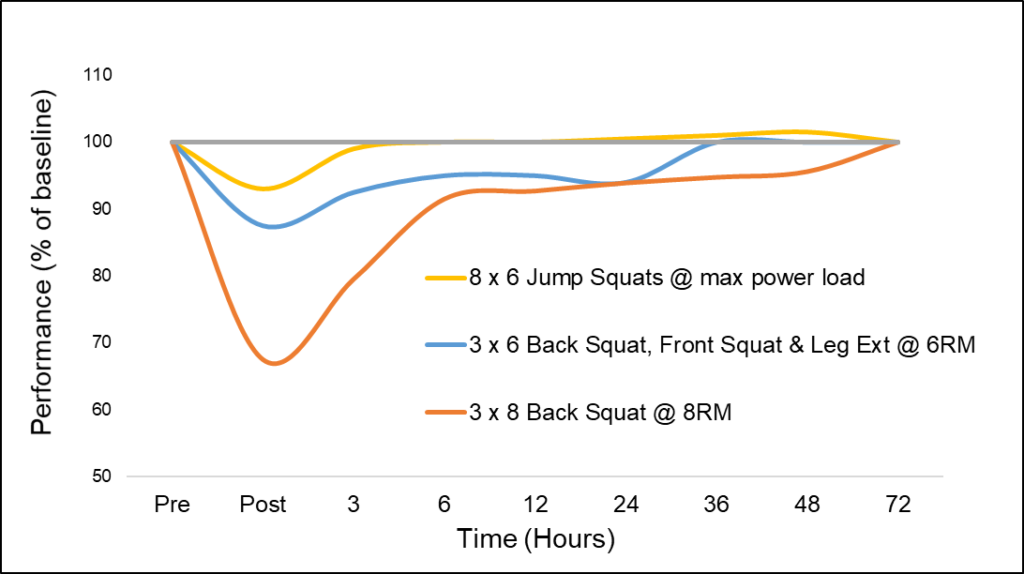
Figure 1. Fatigue and recovery response following various training stimuli (6, 7, 14)
So what do we know about priming?
Maximising performance involves monitoring and managing fatigue, but don’t forget the primary outcome is performance. This requires a change in thought pattern from “how do I minimise fatigue for competition” to “how can I maximise performance for competition”. Resistance exercise, which has been shown to be effective to elicit a priming response, is typically low in volume but high in intensity. This is similar to methods that induce the Type 6 HIIT response, which utilises the neuromuscular system without straining. This can be done through lifting heavy loads (15, 16), or lighter load in a ballistic manner (16-18).Research has shown that priming exercise can enhance subsequent performance measures in as little as 2 hours and up to 48 hours following its completion.Because of the performance-enhancing benefits of priming, practitioners have opportunities within this pre-competition period to prescribe an exercise stimulus that may enhance athletic performance. Figure 2 summarises the results from three different studies. The shaded area of each figure represents the times at which performance was measured in each study (15, 17, 18). However, the time course of performance response across this whole period is unknown. The two different lines in Figure 2 represent some possibilities concerning the time course of performance response. See our recent review published in Sports Medicine in 2019 for a more in depth look at this research.

Figure 2. Priming response following three different priming stimuli (15, 17, 18)
What don’t we know yet?
Is there an ‘optimal’ dose?-
- We know that each individual will respond differently to the same stimulus. However, a 4-6-hour period has been shown to be an effective time for heavier loaded priming exercises (15, 16, 19). Low-moderate load priming has also been shown to benefit performance after 24-48 hours (6, 18).
- However, as demonstrated in Figure 2, the performance response outside of these times aren’t well known, so we don’t yet know when the best time is to prescribe a priming stimulus. We also need to consider how exercise modality, intensity and volume of exercise can be best manipulated for the athletes we work with.
- These are the questions that should be addressed in future research, but you may be able to do some experimenting of your own in your next pre-season, practice game competition, or with a group of development athletes.
-
- Due to the limited research, many performance measures used in recent studies may not accurately represent how athletes will respond physically on the field. A 5% increase in height of a single jump may not be meaningful in the sporting context if this effect remains for only one or two efforts.
- However, if even small improvements were sustained for the entirety of a match/competition, this would be a good indication of improved readiness to perform. There are many measures of performance that would add insight to the effects of priming on global physical capacity. Amongst these, repeated high-intensity efforts may be more representative of the true effect of priming during field based sporting competition (20).
- Additionally, the vertical nature of these jumping tests may not represent the response in sporting movements, which frequently require horizontal and lateral force demands (21).
Moving from research to practice: Consider the whole training context
Whilst the research suggests that a bout of exercise prior to competition can benefit performance in the following 48 hours, these studies are often conducted in relatively controlled lab environments. This environment often does not represent the real-world sport environment, in which athletes aren’t exposed to only one training stimulus prior to competition day. Instead, athletes may in some cases complete 2-3 strength-power sessions in the week leading up to the competition. Take the following examples of a 5-day training schedule for a soccer player in Table 1 which accounts for strength, power and speed training. Which of these 4 training plans would ‘prime’ your group of athletes best? Table 1 Examples of structuring strength, power and speed training leading in to competition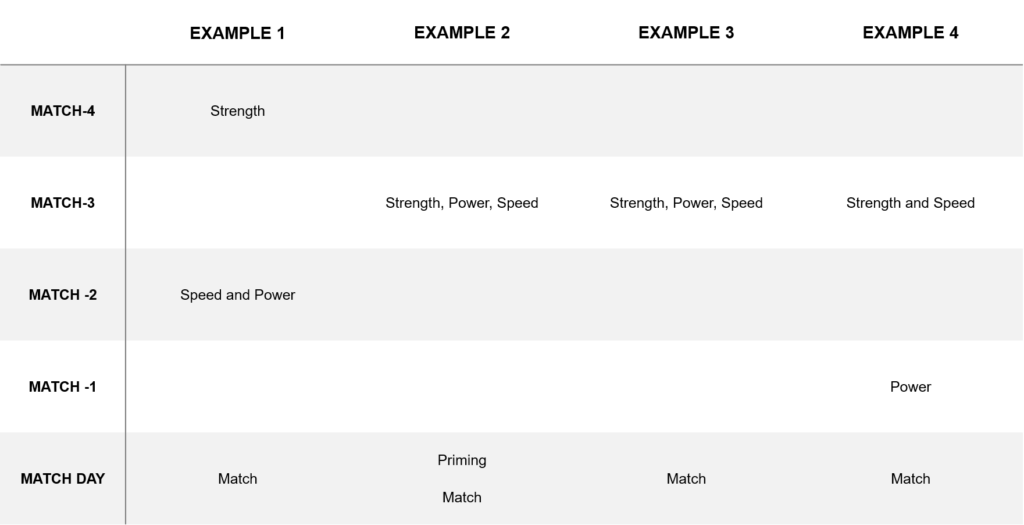 Strength = 4 x 3 Squat variation @ 75-80% 1RM, 4 x 3 Romanian deadlift @ 75-80% 1RM, 4 x 4 Single leg strength variation, 4 x 4 Lateral lunge
Power = 3 x 3 Loaded vertical jump @ 30% 1RM, 3 x 3 Band resisted broad jump, 3 x 3 Band assisted skater jumps
Speed = Speed drill warm up, Build to 2 x maximal accelerations 10m, build to 2 x maximal sprints 40m
Priming = 3 x 2 Half squat @ 60-80%1RM, 2 x 3 Unloaded jumps; vertical, horizontal, lateral
In accordance with our definition of priming (‘exercise prescribed in this 1-48 hour period prior to competition’), Examples 1 and 3 appear to have missed opportunities to prescribe ‘priming’ exercise to enhance performance. However, there’s no way to tell which of these options truly ‘prime’ our athletes most effectively. Future research will need to address this by considering the range of options practitioners have when designing the training week microcycle. Further to this point, we also need to consider the field-based training which is often required up to the day before competition. Therefore, true priming considers how to most effectively distribute all training to maximise performance in your context.
Strength = 4 x 3 Squat variation @ 75-80% 1RM, 4 x 3 Romanian deadlift @ 75-80% 1RM, 4 x 4 Single leg strength variation, 4 x 4 Lateral lunge
Power = 3 x 3 Loaded vertical jump @ 30% 1RM, 3 x 3 Band resisted broad jump, 3 x 3 Band assisted skater jumps
Speed = Speed drill warm up, Build to 2 x maximal accelerations 10m, build to 2 x maximal sprints 40m
Priming = 3 x 2 Half squat @ 60-80%1RM, 2 x 3 Unloaded jumps; vertical, horizontal, lateral
In accordance with our definition of priming (‘exercise prescribed in this 1-48 hour period prior to competition’), Examples 1 and 3 appear to have missed opportunities to prescribe ‘priming’ exercise to enhance performance. However, there’s no way to tell which of these options truly ‘prime’ our athletes most effectively. Future research will need to address this by considering the range of options practitioners have when designing the training week microcycle. Further to this point, we also need to consider the field-based training which is often required up to the day before competition. Therefore, true priming considers how to most effectively distribute all training to maximise performance in your context.
Practical applications – what can you take from the priming literature to your sporting context?
- There are opportunities to impact athlete readiness to perform. This can be done as soon as hours before competition.
- Studies so far suggests that a low volume, high intensity exercise session may be most effective (Type 6 HIIT session responses).
- Power-type exercise may be best applied the day (24-36 hours) before competition.
- Strength stimuli may be best applied on the day, 4-6 hours prior to competition.
- Remember to consider the training stimuli throughout the whole training week. The above points may not apply if you’re already applying a large training stimulus during the week!
- Explore and trial small changes to your program to identify opportunities to enhance athlete preparedness on match day. This may only be with some individuals to begin with. Pre-season periods can also be a perfect opportunity to soft-trial something before implementing anything in season. Remember… we’re not trying to completely overhaul the current program but to identify small changes that may have small but meaningful results.
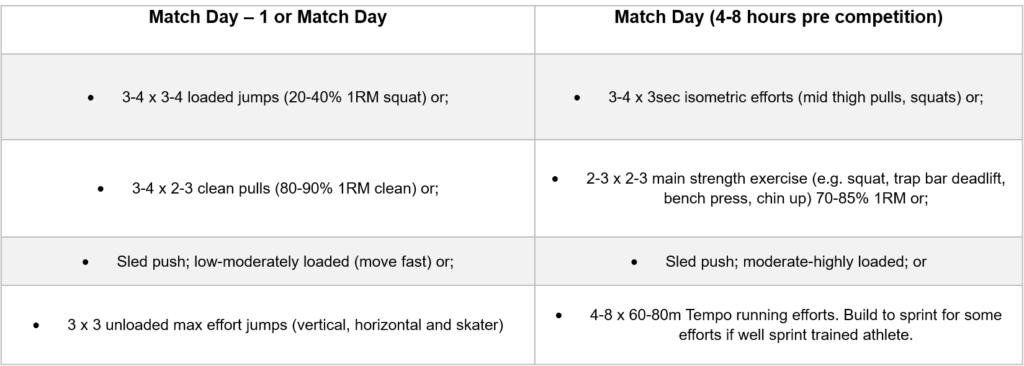
Stay tuned, we hope to have some new research in this area in the near future and believe it’s an area we can definitely learn more about as a field. Feel free to get in touch via Twitter or email below.Twitter: pharrisonAU Email: p.harrison1@uq.edu.au
Further reading and references
- Harrison PW, James LP, McGuigan MR, Jenkins DG, Kelly VG. Resistance Priming to Enhance Neuromuscular Performance in Sport: Evidence, Potential Mechanisms and Directions for Future Research. Sports Med. 2019.
- Issurin VB. New Horizons for the Methodology and Physiology of Training Periodization. Sports Med. 2010;40(3):189-206.
- Mujika I, Padilla S. Scientific bases for precompetition tapering strategies. Med Sci Sports Exerc. 2003;35(7):1182-7.
- Cormie RP, McGuigan UM, Newton UR. Influence of Strength on Magnitude and Mechanisms of Adaptation to Power Training. Medicine & Science in Sports & Exercise. 2010;42(8):1566-81.
- Hartmann H, Wirth K, Keiner M, Mickel C, Sander A, Szilvas E. Short-term Periodization Models: Effects on Strength and Speed-strength Performance. Sports Med. 2015;45(10):1373-86.
- Raastad T, Hallen J. Recovery of skeletal muscle contractility after high- and moderate-intensity strength exercise. Eur J Appl Physiol. 2000;82(3):206-14.
- Gonzalez-Badillo JJ, Rodriguez-Rosell D, Sanchez-Medina L, Ribas J, Lopez-Lopez C, Mora-Custodio R, et al. Short-term Recovery Following Resistance Exercise Leading or not to Failure. Int J Sports Med. 2016;37(4):295-304.
- McCaulley GO, McBride JM, Cormie P, Hudson MB, Nuzzo JL, Quindry JC, et al. Acute hormonal and neuromuscular responses to hypertrophy, strength and power type resistance exercise. European journal of applied physiology. 2009;105(5):695-704.
- Abbiss C, Laursen P. Models to Explain Fatigue during Prolonged Endurance Cycling. Sports Med. 2005;35(10):865-98.
- Carroll TJ, Taylor JL, Gandevia SC. Recovery of central and peripheral neuromuscular fatigue after exercise. J Appl Physiol (1985). 2017;122(5):1068-76.
- Linnamo V, Hakkinen K, Komi PV. Neuromuscular fatigue and recovery in maximal compared to explosive strength loading. Eur J Appl Physiol O. 1998;77(1-2):176-81.
- Linnamo V, Newton RU, Hakkinen K, Komi PV, Davie A, McGuigan M, et al. Neuromuscular responses to explosive and heavy resistance loading. Journal of electromyography and kinesiology : official journal of the International Society of Electrophysiological Kinesiology. 2000;10(6):417-24.
- Moran-Navarro R, Perez CE, Mora-Rodriguez R, de la Cruz-Sanchez E, Gonzalez-Badillo JJ, Sanchez-Medina L, et al. Time course of recovery following resistance training leading or not to failure. European journal of applied physiology. 2017;117(12):2387-99.
- Howatson G, Brandon R, Hunter AM. The response to and recovery from maximum-strength and -power training in elite track and field athletes. Int J Sport Physiol. 2016;11(3):356-62.
- Cook CJ, Kilduff LP, Crewther BT, Beaven M, West DJ. Morning based strength training improves afternoon physical performance in rugby union players. Journal of Science and Medicine in Sport. 2014;17(3):317-21.
- Saez Saez de Villarreal E, Gonzalez-Badillo JJ, Izquierdo M. Optimal warm-up stimuli of muscle activation to enhance short and long-term acute jumping performance. Eur J Appl Physiol. 2007;100(4):393-401.
- Mason BR, Argus CK, Norcott B, Ball NB. Resistance Training Priming Activity Improves Upper-Body Power Output in Rugby Players: Implications for Game Day Performance. J Strength Cond Res. 2017;31(4):913-20.
- Tsoukos A, Veligekas P, Brown LE, Terzis G, Bogdanis GC. Delayed Effects of a Low-Volume, Power-Type Resistance Exercise Session on Explosive Performance. J Strength Cond Res. 2018;32(3):643-50.
- Ekstrand LG, Battaglini CL, McMurray RG, Shields EW. Assessing Explosive Power Production Using the Backward Overhead Shot Throw and the Effects of Morning Resistance Exercise on Afternoon Performance. Journal of Strength and Conditioning Research. 2013;27(1):101-6.
- Natera AO, Cardinale M, Keogh JWL. The Effect of High Volume Power Training on Repeated High-Intensity Performance and the Assessment of Repeat Power Ability: A Systematic Review. Sports Med. 2020.
- Jiménez-Reyes P, Samozino P, García-Ramos A, Cuadrado-Peñafiel V, Brughelli M, Morin J-B. Relationship between vertical and horizontal force-velocity-power profiles in various sports and levels of practice. PeerJ. 2018;6:e5937-e.


